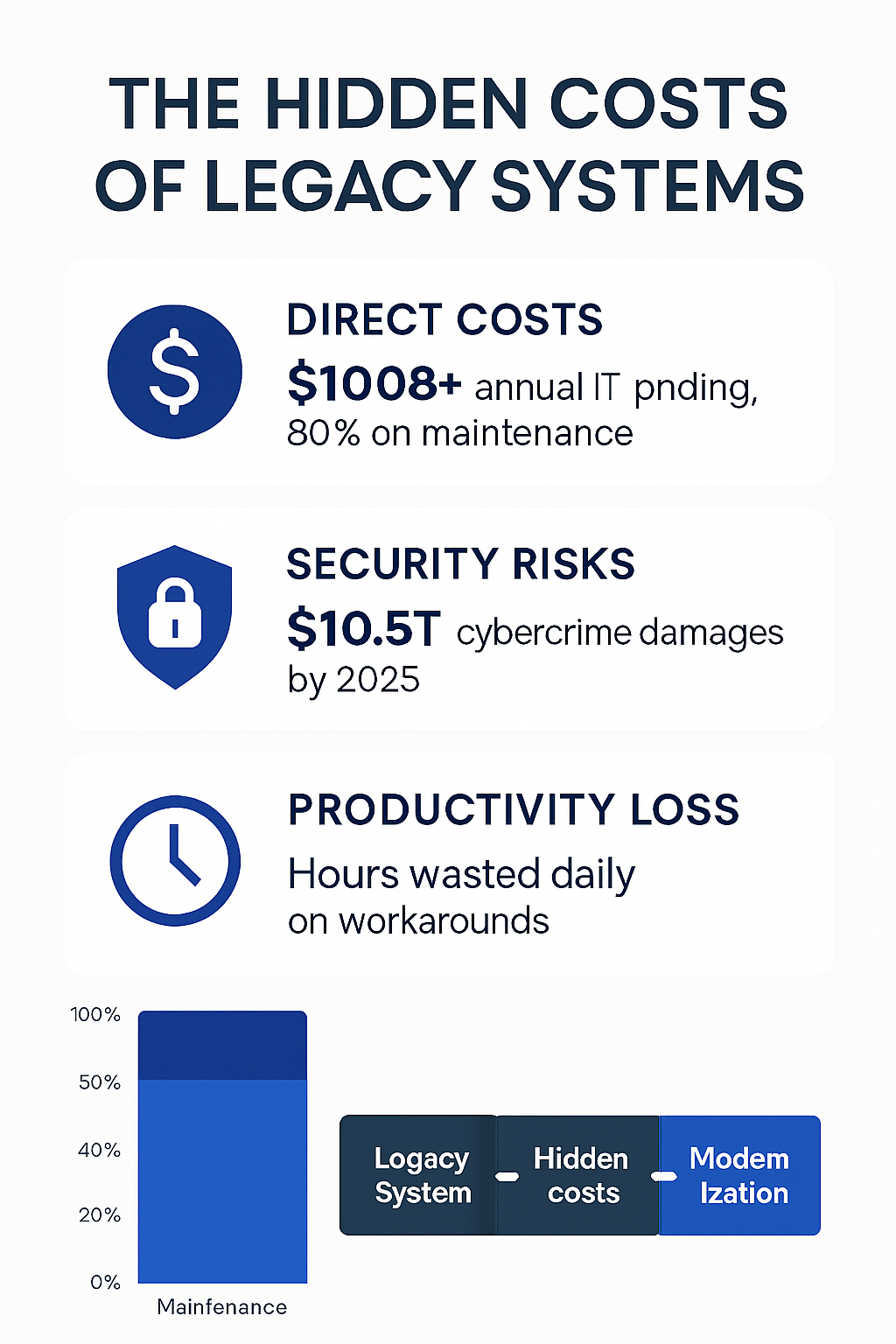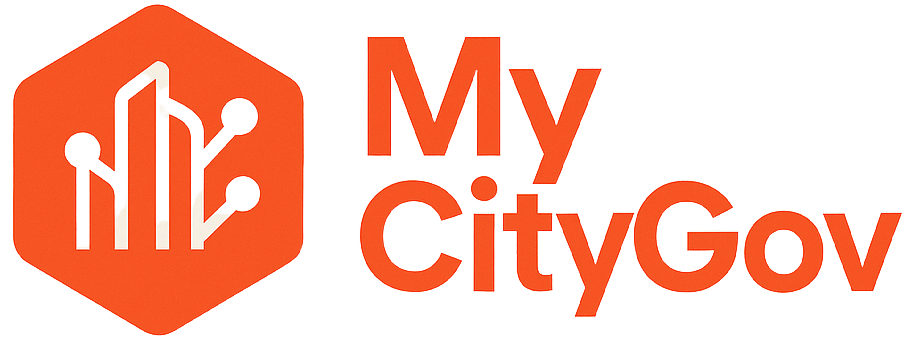
As an IT director or city administrator, you’re likely facing the challenge of maintaining aging technology infrastructure while trying to meet the growing demands of modern government operations. In today’s rapidly evolving digital landscape, legacy government systems are consuming an alarming 80% of IT budgets just for maintenance, leaving little room for innovation or improvement. This comprehensive guide will walk you through the hidden costs of outdated systems, the compelling ROI of modernization, and practical strategies for building a successful business case for upgrading your municipal technology.
The Hidden Price Tag: What Legacy Systems Really Cost Your Municipality
When city leaders think about legacy systems, they often focus on the obvious maintenance expenses. However, the true cost extends far beyond annual vendor contracts and support fees.
Direct Financial Burden
The numbers are staggering. Federal agencies alone spend over $100 billion annually on IT, with approximately 80% dedicated to maintaining existing legacy systems. At the municipal level, this translates to critical resources being locked into outdated infrastructure rather than invested in citizen-facing improvements.
Consider this: the Government Accountability Office identified just 10 critical legacy systems that cost $337 million annually to operate and maintain. For smaller municipalities, even a fraction of these costs can represent a significant portion of the entire IT budget. As systems age, maintenance costs escalate exponentially, requiring increasingly expensive specialized expertise and vendor support that becomes scarcer each year.

The Security Risk Premium
Perhaps the most alarming hidden cost is the security vulnerability of legacy systems. With cybercrime damages projected to reach $10.5 trillion annually by 2025, outdated systems lacking modern encryption, authentication, and patching capabilities represent a ticking time bomb for municipalities.
Nearly 80% of nation-state attacks target government agencies, and legacy systems are often the weakest link. Healthcare data breaches involving legacy applications average $9.77 million per incident—the highest across all industries. For municipalities handling sensitive resident data, a single breach could devastate both finances and public trust.
Workforce and Productivity Drain
Legacy systems create a talent crisis. The average COBOL developer is 55 years old, with 10% retiring annually. Municipalities find themselves competing for a shrinking pool of specialized talent, driving up labor costs while struggling to attract younger IT professionals who prefer working with modern technologies.
Beyond recruitment challenges, outdated systems force employees to develop time-consuming workarounds, leading to errors and significant productivity losses. Studies suggest that inefficient legacy systems can waste hours of employee time daily, resulting in substantial economic losses that rarely appear on budget reports but impact every department’s effectiveness.
The Modernization ROI: Why Upgrading Makes Financial Sense
While the costs of legacy systems are substantial, the return on investment from modernization can be transformative for municipal operations.

Quantifiable Cost Savings
Industry estimates suggest that successful modernization efforts could save the U.S. federal government $7.72 billion in the first year, $23.18 billion by year three, and $38.65 billion by year five. These savings come primarily from reduced maintenance costs, improved operational efficiency, and the elimination of redundant systems.
For municipalities, data center consolidation alone can reduce hardware and operational costs by up to 65%. The U.S. Census Bureau saved $1.9 billion by modernizing its IT infrastructure for the 2020 census, while simultaneously improving website accessibility and reducing user abandonment rates.
Operational Efficiency Gains
Modern systems enable automation of routine tasks, freeing staff to focus on higher-value work. Cities that have integrated finance, HR, and payroll systems report reduced data entry errors, faster approval processes, and better resource allocation. Real-time data access enables faster, more informed decision-making across all departments.
One municipality increased website traffic by 25% and accessibility by 63% through digital modernization, demonstrating how upgraded systems can simultaneously improve internal operations and citizen engagement.
Enhanced Security and Compliance
Modern systems come with built-in security features that would be impossible or prohibitively expensive to retrofit onto legacy platforms. Cloud-native solutions offer automatic updates, advanced threat detection, and compliance with current standards like NIST 800-53 and GDPR—reducing both risk and the administrative burden of maintaining compliance.
Building Your Business Case: Strategies for Municipal Leaders
Making the case for modernization requires more than pointing out problems with current systems. Here’s how to build a compelling argument that resonates with elected officials, budget committees, and stakeholders.
Document the Total Cost of Ownership
Start by calculating the true cost of your current systems, including:
- Annual maintenance and licensing fees
- Staff time spent on workarounds and manual processes
- Security incident response and mitigation costs
- Lost productivity from system downtime
- Opportunity costs of delayed projects and innovations
Many municipalities discover that their legacy systems cost 40-50% more than they realized once all factors are included.
Quantify the Risks
Translate technical risks into business impacts that non-technical decision-makers understand. For example:
- “Our current system has known vulnerabilities that could expose 50,000 residents’ personal information”
- “We’re one ransomware attack away from losing access to critical services for weeks”
- “Our aging workforce means we could lose institutional knowledge and system expertise within 2-3 years”
Present a Phased Modernization Roadmap
Rather than proposing a massive, risky overhaul, present a modular, iterative approach that allows for incremental assessment of impacts. This reduces perceived risk and allows you to demonstrate early wins that build momentum for subsequent phases.
Successful modernization strategies include:
- Starting with high-impact, lower-risk systems
- Establishing clear milestones and success metrics
- Building in flexibility to adjust based on lessons learned
- Ensuring adequate training and change management support
Highlight Citizen Impact
Connect modernization to improved citizen services—the ultimate mission of local government. Show how modern systems will enable:
- 24/7 online access to services and information
- Mobile-friendly interfaces that meet resident expectations
- Faster response times for permits, licenses, and requests
- Better transparency and communication with the community
Studies show that 79% of users expect government websites to match private sector standards, yet 45% of government sites are not mobile-optimized. Modernization directly addresses this expectation gap.
Common Pitfalls to Avoid
Even well-intentioned modernization efforts can falter. Be aware of these common mistakes:
The “Lift-and-Shift” Trap
Simply moving legacy systems to the cloud without redesigning processes fails to address core issues and can actually increase costs. True modernization requires rethinking workflows and taking advantage of cloud-native capabilities.
Underestimating Change Management
Technology is only part of the equation. Successful modernization requires investing in training, communication, and support to help staff adapt to new systems. Organizations that skimp on change management often see low adoption rates and continued reliance on old workarounds.
Lack of Executive Sponsorship
Modernization initiatives need visible support from city leadership. Without a champion at the executive level, projects can stall when they encounter inevitable obstacles or competing priorities.
Taking Action: Your Next Steps
The case for modernizing legacy government systems is clear: the costs of inaction far exceed the investment required for thoughtful, strategic upgrades. With states and local governments budgeting $144 billion for IT in 2024, the question isn’t whether to modernize, but how to do it effectively.
Start by conducting a comprehensive assessment of your current systems, documenting both costs and risks. Engage stakeholders early, including department heads who will be affected by changes. Research vendors with proven experience in municipal technology, and don’t hesitate to learn from other cities that have successfully navigated similar transformations.
The journey toward modernization requires careful planning and the right technology partner. Municipal leaders who take action now will be better positioned to serve their communities effectively, protect sensitive data, and attract the next generation of public sector talent.

Ready to Modernize Your Municipal Technology?
At mycitygov.com, we specialize in helping local governments transition from legacy systems to modern, secure, and user-friendly platforms. Our team understands the unique challenges municipalities face—from budget constraints to compliance requirements—and we’ve helped cities across the country successfully modernize their digital infrastructure.
Contact us today for a free consultation to discuss your specific needs and discover how we can help you build a compelling case for modernization while ensuring a smooth, successful implementation.
Don’t let outdated technology hold your municipality back. Visit mycitygov.com to learn more about our comprehensive municipal website and technology solutions.
